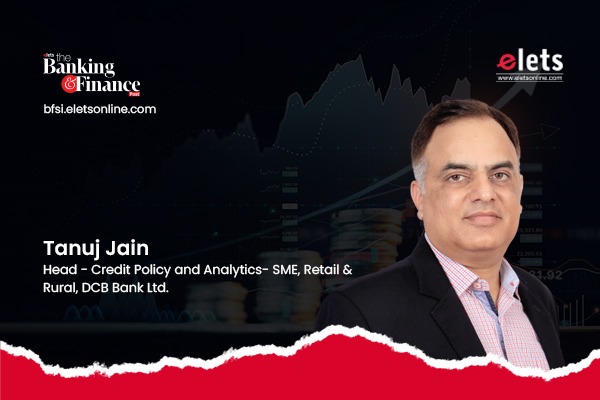With growing customer demands and stringent compliance and regulatory standards, financial services institutions stand to benefit from leveraging the capabilities offered by cloud data platforms. To know how data analytics is providing the answers in the banking space, Rashi Aditi Ghosh of Elets News Network (ENN) interacted with Tanuj Jain, Head – Credit Policy and Analytics- SME, Retail & Rural, DCB Bank Ltd.
Data is redefining the way financial institutions are operating today. Do you agree that ‘Data is the new oil’?
Clive Humby in 2006 and then The Economist in 2017 published a story titled, “The world’s most valuable resource is no longer oil, but data.” I would like to say Data was, Analysis of Data is the new Oil for the Digital Era. Similarities between Oil and Data have got to do with how they become valuable after processing. Enriching of data like crude oil delivers accurate data insights which can drive customer retention, upselling, new revenue models, advertising, etc.
Data is about knowledge, and knowledge is a means to power. Data is changing the way financial institutions have long operated by:
● Better customer experience
● Automated credit approval
● Better risk management
● Capital reconstruction
● Faster fraud detection
● Productive Sales and Marketing Engines
It provides critical insights into how a business is performing and the characteristics of its target audience
In your view, what role is analytics and automation playing in tackling the challenges created by the pandemic for the BFSI sector?
Analytics provides answer. Financial Services organisation have traditionally been product centric but have gradually started transforming to customer centric. This change was accentuated during the pandemic period where personalisation and customer experience were the need of the hour. Initially, fintech startups and later financial services organisations have started to leverage technology and data analytics as per customer preferences.
Key areas that analytics and automation have helped in tackling the challenges during COVID are:
● Putting customers and their needs to the forefront to build solutions with staying power
● Developing a data strategy for personalisation
● Boost operational efficiency
● Smart Insights
● Financial Models
Apart from the standard data sets such as loan history, banking transaction data, demographics, income, etc, new data from sources such as social media and marketing
data can be included in building models to get deeper visibility into customer behaviors. For example, a major life event such as a divorce or a new child, can add significant insights.
The traditional data, together with such new information, can help risk managers create highly robust risk indicators. Such big data analytics can also help banks detect early warning signals in their existing loan servicing business.
Apart from decision making, how significant is data analytics for risk management?
Traditional risk management approaches have been built primarily on subjectivity and individual experiences, which may not be an ideal way of managing an ever evolving risk environment.
Application of data analytics to risk assessment to identify threats to an organisation and develop a clear risk assessment plan for remediating and responding to those threats is the need of the hour:
● Risk identification
● Risk assessment and prioritisation
● Risk response and mitigation
● Risk monitoring
● Risk reporting
Furthermore, it’s applied to credit administration, market and business loans, operational risk, and integrated risk management. Systems empowered with Big Data can recognise fraud signals, break them down continuously by machine learning, and precisely anticipate illegitimate clients as well as exchanges. Big Data offers the capacity to give a global vision of various components and zones identified with financial risk.
Banks and financial institutions use analytics to differentiate between fraudulent transactions and certain commercial transactions. Using analytics and machine learning, they can identify regular activity based on a customers’ history and separate it from unfamiliar conduct that indicates fraud.
Advanced credit risk analytics enable institutions to improve underwriting decisions and increase revenues while reducing risk costs.
Benefits:
Removing guess work
Risk analytics helps take the guesswork out of managing risk-related issues by using a range of techniques and technologies to extrapolate insights, calculate likely scenarios, and predict future events. Application of big data strategy in risk management will help in eliminating the culture of gut-level decision-making on the part of businesses. Emphasis on data-driven decision-making helps in devising out rational decisions while moving the maturity of the organisation’s security culture forward. In an era of rising compliance expectations and increased security concerns, enterprises that embrace rapidly advancing big data solutions will create a robust risk management posture and achieve sustainable business growth.
Understanding complexity
An organisation’s exposure to risk is influenced by increasing volumes of structured data— such as databases—and unstructured data— such as websites, social media, and blogs—that are available to an organisation internally and externally. Risk analytics can be leveraged to integrate this data into a single, unified view, gather valuable information, and enable actionable insights.’
Cross the divide
In their scramble to build effective risk strategies, teams often fail to consider the overall impact to the organisation. Risk analytics pulls data across the organisation into one central platform, helping create a truly enterprise-wide approach.
Also Read | “Data Analytics can bring down the cost to significantly low levels”
Lay the groundwork
Risk is such a wide-ranging issue, spilling across organisational barriers, that it can be hard
to know exactly what to do with risk-related insights. Risk analytics is instrumental in this scenario, allowing organisations to develop foresight with respect to potential risks and zero in on “crunchy” questions that lay the groundwork for action.
How do you see the dynamically changing demands of customers today? Are they the key reason behind data analytics related upgradation in banking?
With growing customer demands, stringent compliance and regulatory standards, financial services institutions stand to benefit from leveraging the capabilities offered by cloud data platforms.
Yes, data analytics and its related upgrade has been one of the major reasons in changing demands of customers today, especially during the post pandemic period. Currently, Financial Institutions (FIs) are able to access and understand customers behavioral data at a very microscopic level to target customers as compared to traditional ways of using the data for major internal analysis and purposes. With the data available in the current digital era, FIs get insights of many complex elements of a person’s life, such as their lifestyle, wants, and preferences. This allows FIs to easily customise the services to the demands of each individual and can use transactional data to anticipate which clients can be sold which financial goods based on their purchasing habits.
Classic example is evolvement of BNPL (Buy Now Pay Later) product which has completely shifted the demand and the purchasing habits because of easily available finance on a click. Similarly, based on the customers transactional data FIs have/are developed/developing credit scorecards to offer customers pre-approved loans for fulfilling their needs. Hence, data analytics has made ease of finance availability which in turn changes the demands of customers today.
What more do you project from emerging technologies like AI and analytics in the next few years?
In my view, the following trends would play a major role in the coming future:
● RPA/ RPM to be at the forefront of process automation
● Automation of every mundane activity
● Usage of macro-economic factors other than customer centric info – war no war, climate change etc
● Process+ model to ensure future unpredictability
● NLP and NLG (Natural Language Generation) data – next level of automation for new product launches and serving the customer
● Transition from CLV (Customer lifetime value) PLV (Potential lifetime value)
AI is showing new ways of customer outreach, but how will privacy invasion and sometimes massive cookie-less data change the way in managing customers, is something to be seen.
Elets The Banking and Finance Post Magazine has carved out a niche for itself in the crowded market with exclusive & unique content. Get in-depth insights on trend-setting innovations & transformation in the BFSI sector. Best offers for Print + Digital issues! Subscribe here➔ www.eletsonline.com/subscription/





















